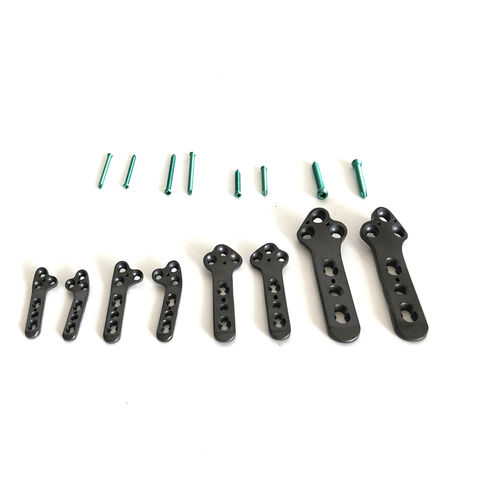Introduction
Titanium is a highly valued material in the medical field, especially in orthopedic implants, due to its unique combination of strength, lightweight, biocompatibility, and corrosion resistance. It has become the preferred material for various orthopedic applications, such as joint replacements, bone plates, and spinal devices. The properties of titanium make it ideal for integration with the human body, offering a long-lasting and safe solution for patients requiring orthopedic interventions.
This article explores the various applications of titanium in orthopedic implants, detailing its features, advantages, production process, and why it is considered the gold standard for orthopedic use.
What Is Titanium Material and Why Is It Used in Orthopedic Implants?
Titanium is a strong, lightweight metal known for its excellent biocompatibility, which means it does not provoke an immune response when implanted in the body. The high strength-to-weight ratio of titanium, combined with its resistance to corrosion and fatigue, makes it the ideal material for orthopedic implants that require both durability and compatibility with the human body.
Features of Titanium Material in Orthopedic Implants
- Biocompatibility: Titanium is non-toxic and biologically inert, meaning it does not trigger adverse reactions when in contact with human tissues. This property makes titanium implants well-tolerated by the body.
- Strength and Durability: Titanium’s high strength ensures that it can withstand the stresses of the human body, even in weight-bearing joints like the hip and knee. Its fatigue resistance makes it durable over extended periods.
- Corrosion Resistance: Titanium forms a protective oxide layer that makes it highly resistant to corrosion, even in the harsh environment of the human body, which is crucial for long-term implant performance.
- Lightweight: Titanium’s lightweight nature reduces the overall burden on bones and joints, making it more comfortable for patients, especially in larger implants like hip replacements.






Applications of Titanium Material in Orthopedic Implants
- Joint Replacements (Hip, Knee, Shoulder): Titanium is extensively used in joint replacement surgeries. The strength and biocompatibility of titanium allow for effective load-bearing, while its corrosion resistance ensures the implant remains intact for many years.
- Bone Plates and Screws: Titanium bone plates and screws are used to stabilize fractures and support bone healing. Their lightweight and non-reactive properties minimize discomfort and the risk of complications during recovery.
- Spinal Implants: Titanium is used in spinal implants, including rods, cages, and screws. Its strength helps support the spine, while its biocompatibility reduces the risk of rejection or inflammation, making it ideal for spinal stabilization surgeries.
- Dental Implants: Titanium is also widely used in dental implants due to its ability to osseointegrate, which means it can bond directly with bone. This feature ensures stable and long-lasting dental prostheses.
Advantages of Titanium Material in Orthopedic Implants
- Osseointegration: Titanium has the unique ability to bond with bone, a process known as osseointegration. This ensures that the implant becomes part of the bone structure, providing stability and reducing the risk of loosening over time.
- Minimized Risk of Allergic Reactions: Titanium’s inert properties reduce the likelihood of allergic reactions or sensitivities, making it suitable for almost all patients, including those with metal allergies.
- Radiolucency: Titanium implants are radiolucent, meaning they do not interfere with X-rays or MRI imaging, which allows doctors to monitor the healing process without obstruction.
- Customization: Titanium can be easily shaped and customized to fit specific patient needs, making it versatile for a wide range of implant designs and surgical requirements.
Production Process of Titanium Implants
- Material Sourcing: The production of titanium implants starts with high-purity titanium, typically sourced in the form of ingots. These ingots are melted and formed into bars or sheets, depending on the type of implant being manufactured.
- Forming and Machining: The titanium is then formed into the required shapes using techniques such as forging, extrusion, or casting. Precision machining ensures that the implants meet exact specifications for proper fit and function.
- Surface Treatment: Titanium implants undergo surface treatments to enhance osseointegration. Methods such as sandblasting, acid etching, or plasma spraying are used to create a rough surface that encourages bone growth around the implant.
- Quality Control: After forming and surface treatment, titanium implants are subjected to rigorous quality control checks, including mechanical testing and biocompatibility assessments, to ensure they meet medical standards and safety requirements.
Comparison: Titanium vs. Other Materials in Orthopedic Implants
- Titanium vs. Stainless Steel: Stainless steel was once the standard material for orthopedic implants, but it is more prone to corrosion and fatigue compared to titanium. Titanium’s superior biocompatibility and strength-to-weight ratio make it the better choice for long-term implantation.
- Titanium vs. Cobalt-Chromium: Cobalt-chromium alloys are used in some orthopedic implants due to their strength. However, they are heavier and less biocompatible than titanium. Titanium implants are preferred for patients with sensitivities to metals.
- Titanium vs. PEEK (Polyetheretherketone): PEEK is a polymer used in some spinal implants, offering flexibility and compatibility with MRI imaging. However, it lacks the strength of titanium and does not promote osseointegration, making titanium a superior choice for load-bearing implants.
Challenges of Using Titanium in Orthopedic Implants
- Cost: Titanium is more expensive than other materials used in orthopedic implants, such as stainless steel. The high cost is due to the complex extraction and production processes required to refine and shape the metal.
- Difficulty in Machining: Titanium is challenging to machine and requires specialized equipment and techniques, which adds to the overall cost of production.
Future Trends in Orthopedic Implants
As medical technology advances, titanium is likely to remain the material of choice for orthopedic implants due to its unmatched combination of strength, biocompatibility, and corrosion resistance. Emerging technologies, such as 3D printing, are making it possible to create customized titanium implants that fit individual patient anatomies precisely. Additionally, surface modifications and coatings are being developed to further enhance the integration of titanium implants with bone, improving patient outcomes.
FAQs about Titanium Material in Orthopedic Implants
- Why is titanium preferred for orthopedic implants?
- Titanium is preferred due to its biocompatibility, strength, lightweight nature, and resistance to corrosion, making it ideal for long-term use in the human body.
- What makes titanium different from stainless steel in implants?
- Titanium is more resistant to corrosion, lighter, and more biocompatible compared to stainless steel, which reduces the risk of adverse reactions.
- Can titanium implants bond with bone?
- Yes, titanium has the ability to bond directly with bone through a process called osseointegration, which provides stability and reduces implant loosening.
- Are titanium implants safe for MRI scans?
- Yes, titanium is non-magnetic and does not interfere with MRI imaging, making it safe for patients undergoing MRI scans.
- Is titanium suitable for patients with metal allergies?
- Titanium is hypoallergenic and well-tolerated by most patients, including those with sensitivities to other metals.
- What types of orthopedic implants are made from titanium?
- Titanium is used in joint replacements (hip, knee, shoulder), bone plates, screws, spinal implants, and dental implants.
- How are titanium implants manufactured?
- Titanium implants are made through forming, machining, and surface treatments, followed by rigorous quality control to ensure safety and efficacy.
- What are the advantages of titanium over cobalt-chromium implants?
- Titanium is lighter, more biocompatible, and promotes osseointegration, whereas cobalt-chromium is heavier and less suitable for patients with metal allergies.
- Do titanium implants require special care?
- Titanium implants do not require special care beyond regular medical follow-up, as they are highly durable and resistant to corrosion.
- Can titanium implants be used in spinal surgeries?
- Yes, titanium is commonly used in spinal implants, including rods, cages, and screws, due to its strength and biocompatibility.
- What is the role of surface treatment in titanium implants?
- Surface treatments enhance osseointegration by creating a rough surface that encourages bone growth, improving the stability of the implant.
- Are there any disadvantages to using titanium in implants?
- The main disadvantages are the higher cost and the difficulty in machining titanium, which requires specialized equipment.
- How does titanium compare to PEEK in orthopedic implants?
- Titanium is stronger and promotes osseointegration, whereas PEEK is lighter and more flexible but lacks the strength and bonding capabilities of titanium.
- Can titanium implants last a lifetime?
- Titanium implants are designed to be long-lasting, often lasting many years or even a lifetime, depending on the patient and the type of implant.
- Is titanium used in dental implants?
- Yes, titanium is widely used in dental implants due to its ability to integrate with the jawbone, providing a stable foundation for dental prostheses.
Conclusion
Titanium has revolutionized orthopedic implants by providing a material that is strong, biocompatible, and corrosion-resistant. Its ability to bond with bone, combined with its lightweight nature, makes it an ideal choice for a wide range of orthopedic applications, from joint replacements to spinal stabilization. While there are challenges, such as cost and machining difficulties, the benefits of titanium far






